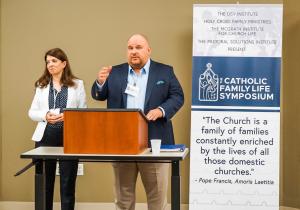The following article is part of our ongoing series on the Liturgy of Domestic Church Life. To learn more, join our Facebook discussion group: CatholicHŌM (Households on Mission)–Family Discipleship.
– – –
On our radio program today, we got a call from a gentleman who accidentally offended his wife of 20 years by saying that if he had the relationship he  has with God now when he was coming out of high school, he might have become a priest. He said that his wife, upon hearing this, felt like she was some kind of consolation prize. Of course he didn’t mean it that way. He said he just meant that he was a little envious of the opportunities a priest has to live so single-mindedly for God and that he sometimes struggles to experience God as deeply as he would like with all the distractions of daily work and family life.
has with God now when he was coming out of high school, he might have become a priest. He said that his wife, upon hearing this, felt like she was some kind of consolation prize. Of course he didn’t mean it that way. He said he just meant that he was a little envious of the opportunities a priest has to live so single-mindedly for God and that he sometimes struggles to experience God as deeply as he would like with all the distractions of daily work and family life.
Of course he isn’t alone. I think most faithful lay people have felt this way from time to time. I think most faithful Catholics–men and women–feel a similar call to “priesthood” at some point. What most people miss is that this genuine and authentic call to priesthood isn’t necessarily a call to the ministerial priesthood. For most of us, the call to priesthood is a call to more deeply live the ministry of the “common priesthood,” but frankly, for a lot of Catholics, this feels like “second skimmings.” That’s not because the common priesthood is any less important in the Kingdom of God, but because we haven’t effectively developed the theology of the common priesthood and what it means to celebrate it .
This is one of the reasons what we are calling the Liturgy of Domestic Church Life is so important. The Liturgy of Domestic Church Life offers a more systematic way to appreciate how the common priesthood of the laity complements the ministerial priesthood and the Liturgy of the Eucharist. It gives us a way to relate to the common priesthood in a way that doesn’t feel like we’re being patted on the head and told, “There, there, lay person. Of course you matter too.”
Two Priesthoods, One Christ.
Theologian, David Fagerberg, points to this complementarity between the lay and ministerial priesthood when he writes,
The common priesthood of the laity is directed toward the cure of this now corrupted structure of the world, and the ministerial priesthood is at the service of the common priesthood to equip them for their lay apostolate….. Therefore, “though they differ from one another in essence and not only in degree, the common priesthood of the faithful and the ministerial… priesthood are nonetheless interrelated: each of them in its own special way is a participation in the one priesthood of Christ” (2004).
It’s inherent to the nature of priesthood to preside over liturgy. For instance, that’s why the church celebrates the institution of both the eucharist and the ministerial priesthood on Holy Thursday. The two are inextricably tied. It’s impossible to speak of priesthood without simultaneously referencing the liturgy over which the priest presides. The ministerial priesthood consecrates the bread and wine into the Body and Blood of Christ through the Liturgy of the Eucharist. In a sense, the common priesthood consecrates the world to Christ through the Liturgy of Domestic Church Life. In the words of one Eastern-Rite bishop who attended a talk on the Liturgy of Domestic Church Life model, “The Liturgy of Domestic Church Life represents the mystical vehicle that allows the grace of the Eucharist to be communicated to all the world through the living Body of Christ.”
What’s the Liturgy of the Common Priesthood?
I would argue that our understanding of the value and dignity of the “common priesthood of the laity” has suffered for so long because we’ve been attempting to talk about it without adequately defining the Liturgy of Domestic Church Life to which it is inextricably attached. Building the Kingdom of God doesn’t necessarily require us to “do BIG THINGS for Jesus” like building hospitals and converting entire nations to Christ. For most of us, building the Kingdom of God simply requires cooperating with grace to heal the way sin damages our relationships. The common priesthood facilitates this necessary and essential process of healing through the Liturgy of Domestic Church Life.
Loosely speaking, it’s the role of the common priesthood to build and heal the Body of Christ while it is the role of the ministerial priesthood to feed the body of Christ. And although Catholics haven’t historically tended to think of it in these terms, both roles are of equal importance and dignity. Seen through this lens, creating strong families through the Liturgy of Domestic Church Life isn’t just a nice thing to do. It is the primary way the common priesthood of the laity participates in the salvific mission of the Church.
Two Liturgies Making Love Incarnate
Similar to the way that the ministerial and common priesthoods represent distinct yet complementary means of participating in the one priesthood of Christ, the Liturgy of Domestic Church Life should be thought of as a true liturgy that is distinct from, yet complementary to, the Liturgy of the Eucharist. Of course, the relationship between these two liturgies is enhanced by the fact that they are the only two liturgies where love, itself, becomes incarnate in flesh and blood—the former through the conception of children and the latter through the consecration of the Precious Body and Blood.
Your marriage and family life should never be seen as an obstacle to living your call to the priesthood. Your call to the common priesthood isn’t a lesser The fact is, Catholicism is meant to be “a kingdom of priests” (Exodus 19:6). The common priesthood is a real priesthood that presides over a real liturgy. Celebrating the Liturgy of Domestic Church Life means celebrating–in a manner of speaking–that you are parent forever in the line of Malchizedek (c.f., Hebrews 7:17), a full participant in the one priesthood of Christ that serves as the source of the power, dignity, and spiritual authority of both the ministerial and common priesthood.
Dr Greg Popcak is the author of many books and the director of both CatholicCounselors.com and the Peyton institute for Domestic Church Life. You can hear him and his wife Lisa each day on their call-in radio program, More2Life airing Monday-Friday at 10amE on EWTN Radio and SiriusXM130.




